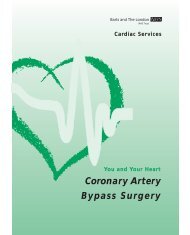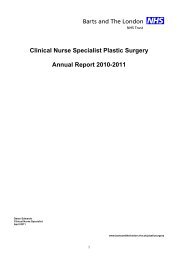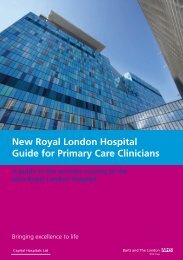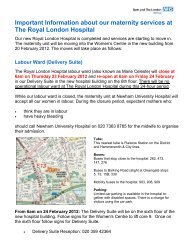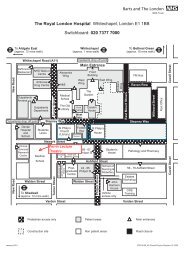Quality of surgical instruments - Barts and the London NHS Trust
Quality of surgical instruments - Barts and the London NHS Trust
Quality of surgical instruments - Barts and the London NHS Trust
You also want an ePaper? Increase the reach of your titles
YUMPU automatically turns print PDFs into web optimized ePapers that Google loves.
BROPHY SRODON BRIGGS BARRY STEATHAM BIRCH QUALITY OF SURGICAL INSTRUMENTS<br />
2<br />
Table 1 Identified instrument flaws<br />
Number <strong>of</strong><br />
Principal flaw <strong>instruments</strong><br />
Machining burrs in teeth 116<br />
Sharp burrs on h<strong>and</strong>le grips 8<br />
Soldering faults 47<br />
Cracks 91<br />
Failure <strong>of</strong> cutting action 34<br />
Failure <strong>of</strong> correct meshing <strong>of</strong> ratchets 71<br />
Failure <strong>of</strong> jaws <strong>of</strong> needle holders 36<br />
Protruding tissue forceps guide pins 35<br />
Corrosion 28<br />
Deficient electrical insulation 10<br />
Absent manufacturer’s mark 254<br />
Discussion<br />
The commonest fault identified was lack <strong>of</strong> a maker’s mark.<br />
BS states that ‘<strong>the</strong> instrument shall be marked with <strong>the</strong><br />
name or registered trade mark <strong>of</strong> <strong>the</strong> manufacturer or<br />
supplier’. 1 This may seem like a minor infringement, but in<br />
fact it is highly important. If an instrument fails in service, it<br />
is essential that <strong>the</strong> supplier <strong>and</strong> manufacturer can be<br />
notified, so that any potential problem can be rectified, to<br />
ensure <strong>the</strong> safety <strong>of</strong> <strong>the</strong> patient <strong>and</strong> <strong>the</strong>atre staff. In addition,<br />
<strong>the</strong>re is <strong>the</strong> question <strong>of</strong> liability <strong>and</strong> insurance.<br />
Ann R Coll Surg Engl 2006; 88: 000–000<br />
The commonest mechanical <strong>and</strong> structural fault was<br />
machining burr debris. BS states that ‘all surfaces must be<br />
free from pores, crevices <strong>and</strong> grinding marks’. 1 The fine<br />
metallic surfaces <strong>of</strong> <strong>surgical</strong> <strong>instruments</strong> are <strong>the</strong> product <strong>of</strong><br />
a number <strong>of</strong> engineering processes. The shapes <strong>and</strong> details<br />
are initially created by casting <strong>and</strong> pressing <strong>the</strong> metal into<br />
<strong>the</strong> required shape, but <strong>the</strong>n finer detail is ground in. In<br />
modern, computer-controlled, laser-guided engineering,<br />
this should be a straightforward <strong>and</strong> reliable process, producing<br />
an extremely accurate surface, as is shown in <strong>the</strong><br />
upper view <strong>of</strong> Figure 1. Sometimes, older methods are used<br />
but a fine finish should still be possible, as long as <strong>the</strong> surface<br />
is inspected <strong>and</strong> machine brush-polished. If this<br />
process is incomplete, metallic debris <strong>and</strong> surface imperfections<br />
will remain as shown in <strong>the</strong> middle view <strong>of</strong> Figure<br />
1. This may be a problem in a number <strong>of</strong> ways. First, blood<br />
<strong>and</strong> tissue debris may collect in <strong>the</strong> imperfect surface. We<br />
have traditionally relied on sterilisation procedures to render<br />
such debris inert, but <strong>the</strong>re are now concerns that prion<br />
disease may survive such processes. 2 The metallic fragments<br />
may also wear <strong>of</strong>f <strong>the</strong>se surfaces, <strong>and</strong> remain as<br />
microscopic debris in <strong>the</strong> wound. Sharp burrs on instrument<br />
h<strong>and</strong>les may contribute to previously unexplained<br />
<strong>surgical</strong> glove punctures. Although we cannot reference<br />
any reported instance <strong>of</strong> this, BS states that ‘<strong>the</strong>re shall be<br />
no sharp edges o<strong>the</strong>r than those required by <strong>the</strong> pattern <strong>of</strong><br />
<strong>the</strong> instrument’. 1<br />
Cracks <strong>and</strong> soldering faults may also provide niches for<br />
retention <strong>of</strong> blood <strong>and</strong> tissue, <strong>and</strong> serious defects may lead to<br />
instrument failure, such as <strong>the</strong> examples shown in Figure 2.<br />
Figure 1 Magnified views <strong>of</strong> <strong>the</strong> jaws <strong>of</strong> vascular clamps – a well-finished example on <strong>the</strong> left, poorly finished examples in <strong>the</strong> middle <strong>and</strong> right views.



